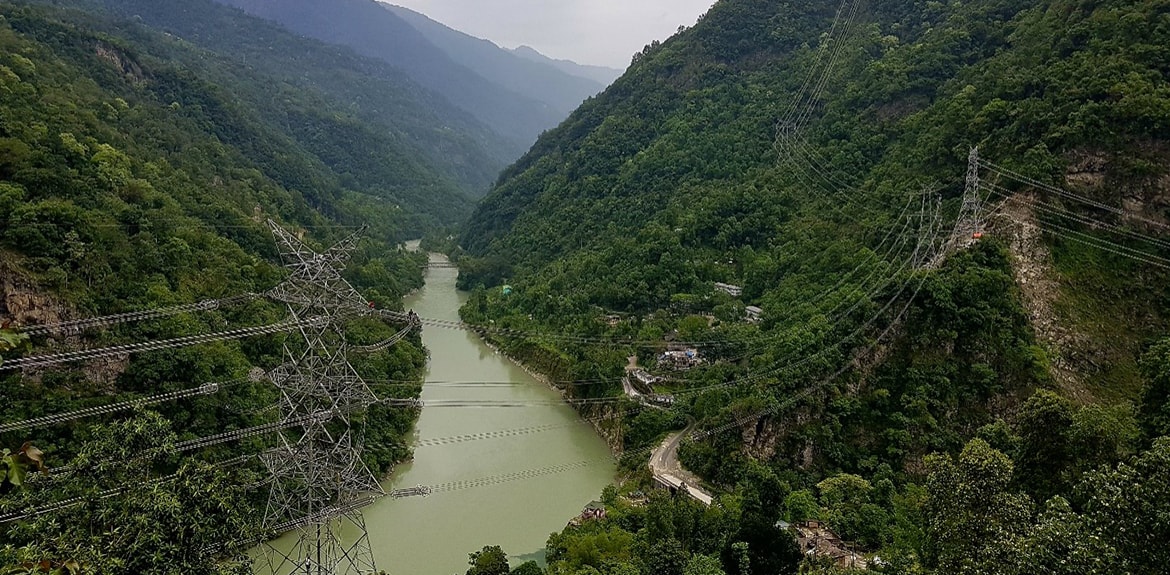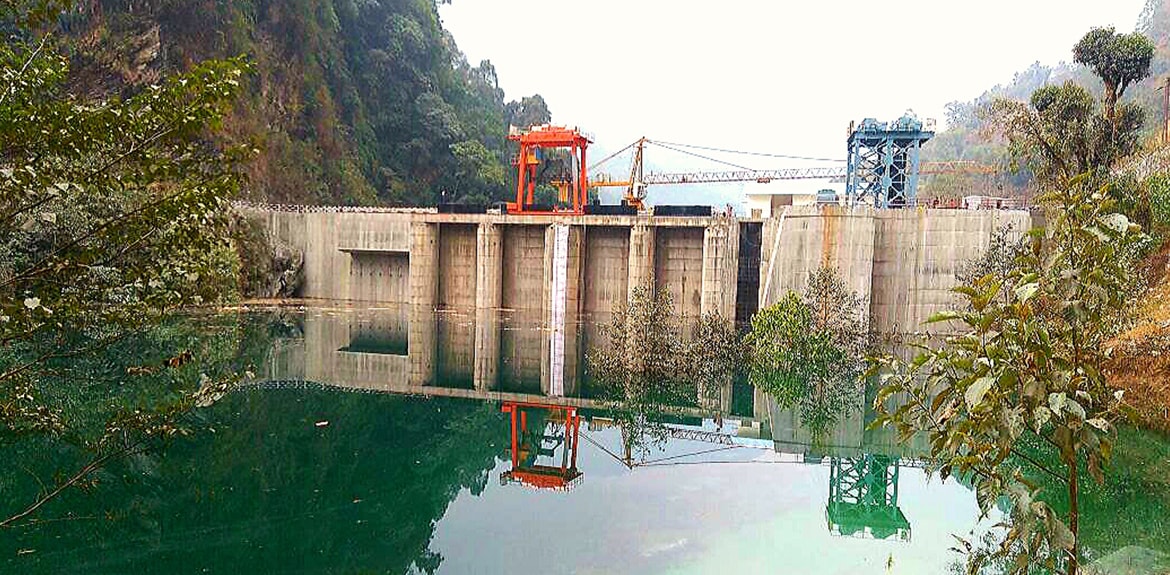Greenko has developed the 96 MW Dikchu Hydro-electric Project as a green field project under the most challenging Geological, Social, Environmental and Logistical conditions. Dikchu Project is located in the North-Eastern state of Sikkim and nestled in Greater Himalayas with fragile Himalayan geology and fraught with very inclement/ adverse weather conditions. The Project overlooks Khangchendzonga, the world’s third highest mountain and the catchment area comprises glaciers on the Indo- Tibetan border.
Sikkim is a high rainfall area with light to heavy rains for almost 8 months i.e. from February to Oct and with acute winters with temperatures falling to -4 Deg C in Dam area.
Accessibility & Logistics Challenges:
The project components are located around 100 to 150 km. from the nearest Railhead and Airport and accessible only through one road which is highly vulnerable to frequent landslides and traffic blocks. For accessing individual remote project components viz. Dam, Head-Race-Tunnel, Surge Shaft and Pressure Shaft separate access roads of more than 15 km. length and 4 no. bridges were constructed on extremely steep terrain and unstable slopes and maintained pliable round the clock. Lots of construction materials viz. steel, cement, aggregates, fuel, Plant, machinery and equipment etc. were transported through these trying and narrow roads at times passing through habitations. For transporting the heavy 400 kV transformers, the bridges en-route from Siliguri to Dikchu were strengthened. In-order to manage the round-the-clock construction on all fronts, almost 100% standby equipment was maintained. Uninterrupted construction power was ensured with adequate DG sets as standby at all work fronts and establishments.
Construction challenges:
Except the Dam, all Project components are underground construction works viz. more than 10 km. of tunnelling, three underground caverns, Surge Shaft, 335 m. deep vertical Pressure Shaft etc. which are located in very fragile Himalayan geology with high Mica and Schist contents, high water ingress and adverse gradients. State of the art construction techniques were adopted to manage the geological challenges. The River Diversion for construction of the Dam was carried out in the very narrow gorge (technical paper as case study presented in Hydrovision Brazil-2013, authored by Mr. P.M. Nanda and Mr. A. Vijay Kumar). When power evacuation challenges were posed at a late stage of project implementation due to changed evacuation scenario, Greenko rose to the occasion, showed strong perseverance and resilience and resolved the issue by constructing the 400 kV substation and LILO connection towers in extremely constrained spaces and adverse topography in record time.
The construction works progressed amidst many flash floods of high intensity and two massive and well known EarthQuakes- ‘Sikkim’ and ‘Nepal’ Earthquakes, of 6.8 magnitudes.
Environment challenges:
As the project works were required to be carried out in the Pristine Himalayan ecology, it’s a huge challenge to manage the environmental impact challenges and to comply with the stringent environmental conditions, and it was done in an impeccable manner. All the excavated muck generated from the underground and surface construction works was dumped and stacked perfectly in the designated dumping areas with perfect retaining structures and reclaimed in scientific methods. Meticulous precautions were taken to maintain the Ambient Air, Water, Soil and Noise parameters at original levels, without any impact of construction works on them or on the Flora and Fauna. Global standards of Health & Safety were adhered to at all work fronts during project construction, including enforcing strict compliance through the construction contractors.
Social challenges:
The smooth execution of the project in an alien and remote area was possible because of ‘Winning the Hearts of Communities’ (WHC) and maintaining absolute Social Peace. Excellent relations were maintained with all stakeholders- local communities, groups, leaders, admin/authorities. Lots of employment, avenues, entrepreneur opportunities viz. contracting for the works, supplies, hiring of vehicles etc. were provided to the local people. Around 300 local people were employed (from unskilled workers to senior executive levels) during the project construction. Around 220 local contractors were awarded various work/supplies amounting to around Rs. 75 Cr. Lot many Local Area Development works CSR works were carried out in areas of educational, religious, infrastructure development, medical facilities and material support for conversion of katcha houses to pucca houses. A number of Medical camps were organised for the benefit of the project area villages, in association with the local medical college, utilising the services of the specialist doctors.
Management techniques:
Project construction was managed using highly sophisticated Project management systems (software based), round the clock monitoring, on the spot decision making, highest level of supervision, meticulous Quality Control & Assurance system. Highly dedicated, capable and spirited team of people were engaged in execution and completion of the project under most challenging conditions.
State of the Art Generating Equipment & Systems: Highly efficient generating Plant & Machinery with full automation and real-time health condition monitoring instrumentation were chosen and installed. The Erection, Testing and Commissioning activities were planned immaculately. The first unit synchronising was completed within 10 minutes of back charging which is a record of a kind in itself.
Since commissioning the Dikchu Hydro Electric Plant is running smooth and trouble free with more than 99% machine availabilities.
96.0 MW
OPERATIONAL CAPACITY
35 m High
DIVERSION STRUCTURE
240 Sq Km
CATCHMENT AREA
550 Mn Units
UNITS GENERATED


